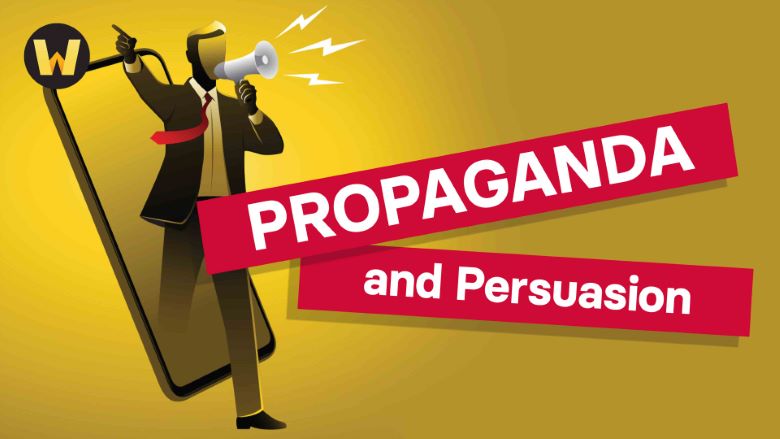در حال حاضر محصولی در سبد خرید شما وجود ندارد.

Persuasion is a central element of our daily lives. Whether it is a politician angling for a vote, a business advertising a product, a parent asking a child to get dressed, or a friend suggesting a certain restaurant for dinner, we are constantly trying to persuade others to our point of view, and experiencing others’ attempts to persuade us.
Persuasion—along with its cousins: propaganda, manipulation, and coercion—has always been part of the human experience. The 20th and 21st centuries, however, have seen the rise of mass media and an explosion of digital messaging, making it critical for us to understand the tools and science of persuasion.
Today, not only do we need to be able to influence others, but we must be able to recognize when the techniques of persuasion are being used on us. Propaganda and Persuasion gives you a one-of-a-kind opportunity to explore the powerful, fascinating—and occasionally dangerous—world of influence. Taught by Professor Dannagal G. Young of the University of Delaware, these 12 eye-opening lectures arm you with the tools of effective communication and the insight to understand—and perhaps resist—persuasion in all its forms.
As you will discover, the domains of persuasion and propaganda include politics, advertising, relationships, public health, social media, and more. Professor Young walks you through each of these, beginning with a historical account of persuasion. Here you will:
Successfully navigating our contemporary world means understanding persuasion in speech, media, messaging, imagery, and more. Propaganda and Persuasion is, therefore, an invaluable resource for your life as a citizen, colleague, consumer, and human being at large.
Explore Mass Media and Persuasion
One of your first lectures in this course is an examination of how mass media completely upended civilization in the early 20th century. Thanks to books, newspapers, and radio, even though people were spread out geographically, those individuals (called “masses”) could receive the same messages and perhaps even be influenced in similar ways.
Public relations and consumer marketing are so prevalent in our lives today that it can be astonishing to step back and consider that entire communication fields had to be invented. For example, you will meet Edward Bernays, considered “the father of public relations,” who in the early 20th century recognized the opportunity of mass media and developed communications for the anonymous “masses.”
And, of course, there was a dark side to these developments. Professor Young shows how Adolph Hitler learned from the American propaganda techniques of World War I and perfected them in the engine of death that was the Third Reich. Examining the control of media and messaging in Nazi Germany lays bare the distinction between “persuasion”—which requires a free choice—and “propaganda.”
Mass persuasion is fraught with difficult ethical questions. What is the difference between ethical persuasion and manipulation or coercion? How can you employ the techniques of persuasion while still respecting an individual’s free will?
Unpack the Mechanisms of Persuasion
To dive into these thorny issues of persuasion and propaganda, Professor Young introduces social science frameworks that explain why people respond to certain kinds of persuasion. For example, if someone says they value “health,” but their diet or exercise habits suggest otherwise, what’s going on? What is their motivation?
Human beings are complex and nuanced creatures, so a study of persuasion is really an examination of the deepest recesses of our minds. Sometimes we are persuaded by Aristotle’s “logos” (cool rationality); whereas, other times we need an appeal to “pathos” (an emotional hook) to move us. But, as you will discover, the question of “logos” versus “pathos” is not an either/or, but rather a both/and proposition. We are persuaded by reason and emotion, often at the very same time.
One of the more astonishing developments in the second half of the 20th century is the development of meaning-making advertising. Whereas older advertisements tended to sell the features of a product, post-war advertising began leaning on the power of meaning-making. For example, you couldn’t advertise the flavor of Coca-Cola® through the medium of television, but you could pair the soft drink with a scene of unity—linking the brand of Coke® to a larger meaning.
One way to create meaning is through the power of stories. Professor Young will show you how storytelling, as well as jokes and humor, can disarm you as the reader or listener. When listening to a story or a joke, you might let your guard down and be more susceptible to persuasion without even realizing it.
The ethics of such persuasion are complicated—and have become even more important in the digital age.
What Does the Future Look Like?
The first generations of “masses” were bombarded with persuasion in advertising and politics. Today, our lives are deeply integrated with digital communication and social media. Not only must we recognize the effects of native advertising and social media influencers, but we must also actively guard against the spread of misinformation and conspiracy theories.
In the final lectures of this course, Professor Young examines recent political campaigns and the viral spread of conspiracy theories. Some conspiracy theories are outlandish and obviously false, but misinformation is often about feelings rather than facts, making it harder to debunk. What’s more, with so many messages out there, many of which are tailored to our preexisting attitudes, it becomes harder and harder to resist the influence of persuasion.
What do we do about this? How should we live as citizens committed to the truth? What does the future of persuasion look like? Propaganda and Persuasion is a powerful antidote to the insidious forces of propaganda and manipulation. With Professor Young’s guidance, you will be a savvier consumer of information—and a healthier citizen.
در این روش نیاز به افزودن محصول به سبد خرید و تکمیل اطلاعات نیست و شما پس از وارد کردن ایمیل خود و طی کردن مراحل پرداخت لینک های دریافت محصولات را در ایمیل خود دریافت خواهید کرد.